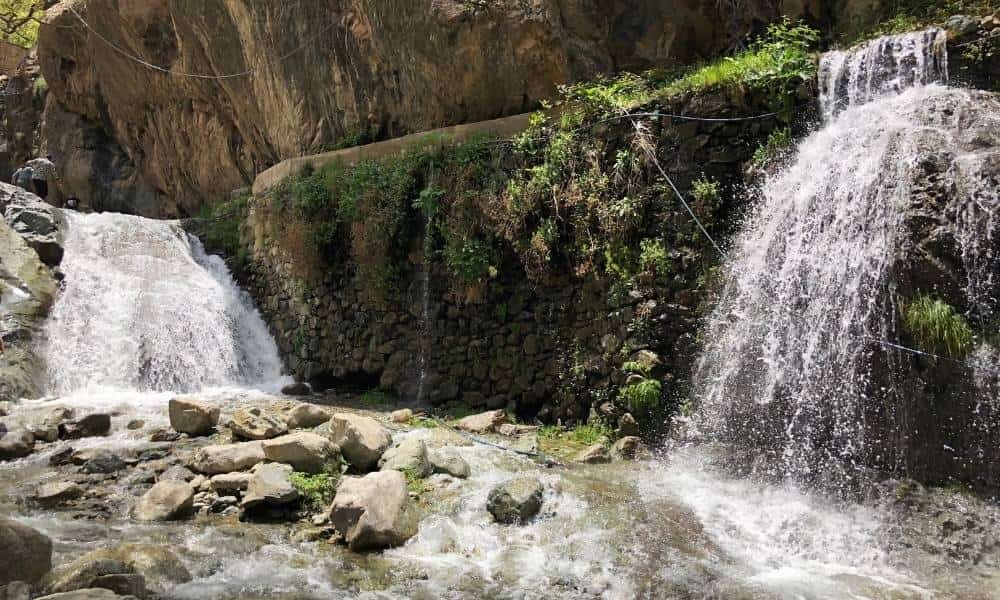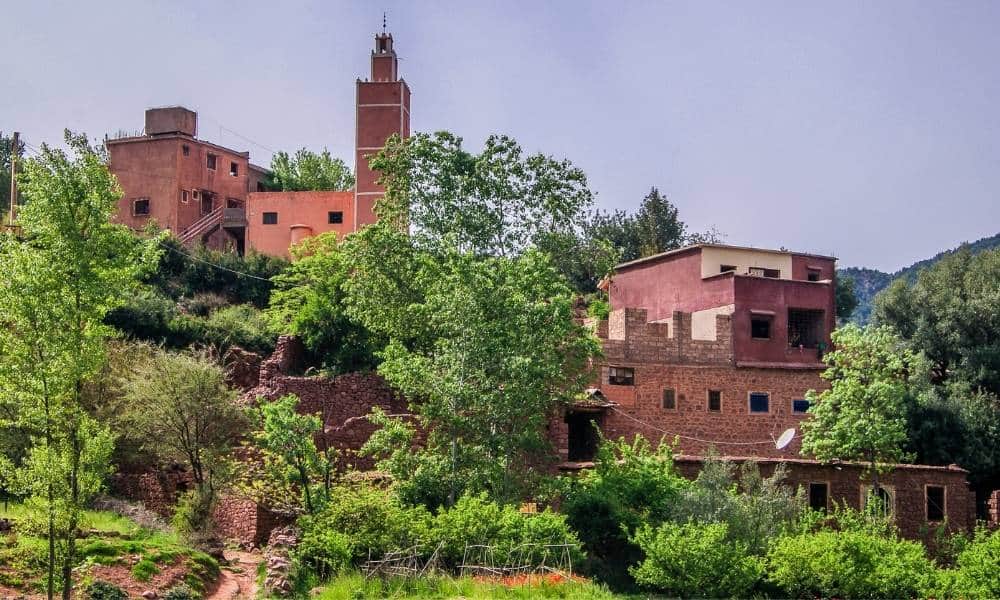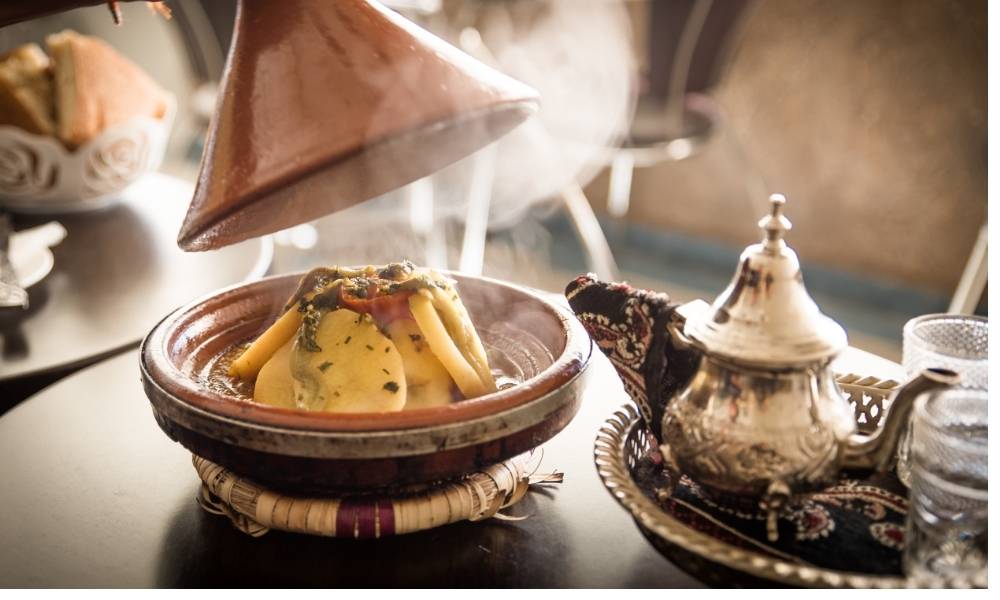The pretty Ourika Valley is a popular excursion from Morocco’s “Red City” of Marrakech.
Located in the foothills of the soaring Atlas Mountains and just 42 kilometres (26 miles) from the old imperial city, travelling to Ourika Valley from Marrakech takes around an hour.
The atmosphere is a lot different in Ourika Valley, with a more relaxed and laid-back vibe.
The scenery is certainly very different too; swap grand architecture, bustling souks, and remnants of royalty for beautiful mountain views, scenic waterfalls, and outdoor adventures.
You can also get a glimpse of traditional Berber life and enjoy somewhat cooler temperatures.

Many people opt to visit Ourika Valley from Marrakech on a day trip, though it is possible to stay for longer and you’ll certainly find plenty to occupy your time.
Here’s everything you need to know about visiting Ourika Valley from Marrakech:
Table of Contents
Getting to Ourika Valley
Several operators offer day trips to Ourika Valley from Marrakech, leaving early in the morning and returning in time for dinner.
Prices are reasonable and lunch is often included in the trip. Almost all accommodations can help you to book an excursion.
If you want greater freedom to explore the area, renting a vehicle gives you plenty of flexibility.
There are several places in Marrakech where you can hire a car, although you should be prepared to drive in the mountains.
With more cash to spend, chartering a private taxi can be a good way for a small group of people to experience Ourika Valley at their own pace.
Negotiate prices to get the best deal.
If you want to travel independently to Ourika Valley with a view to staying overnight (or longer), catching a shared taxi can be a cost effective way of reaching the mountains.
Shared grand taxis run between Marrakech and Lagrab and you can then continue to the main hub of Setti Fatma or Tafza by local minivan.

Keep in mind that this can be a slower option as vehicles wait until seats are taken (or until other passengers cover the costs of empty seats).
Conditions can be cramped and the journey may not be particularly comfortable.
Opting to travel to Ourika Valley in this way also means that you need to find transportation (such as local taxis) if you wish to move around in the area.
Accommodation in Ourika Valley
There are diverse accommodation options in Ourika Valley catering to varying budgets and requirements.
Whether you’re looking for a welcoming and friendly homestay or a luxury hotel with a wide array of facilities, you’ll find somewhere great to stay in Ourika Valley.
Do keep in mind, however, that if you stay in one of the more remote accommodations that you will almost certainly need your own transportation to fully make the most of your trip.
Hotels and hostels in Setti Fatma are within walking distance of the river and waterfall.
Best Time to Visit Ourika Valley
Although trips to Ourika Valley are popular at all times of the year, February to April is a brilliant time to enjoy pleasant temperatures and see wildflowers, cherry blossom, and almond orchards in full bloom.
April to May is considered the best time for trekking. Autumn (October and November) also offers good conditions for trekking.
The summer months are ideal for dipping your feet in the river and falls and if you don’t plan on being exceptionally active—the higher temperatures can make hiking uncomfortable.
The scenery is still pretty in winter, but the cold weather can put people off visiting. If you want to hike to higher elevations in the mountains, winter isn’t the best time to visit Ourika Valley.
Culture and History in Ourika Valley
Although Ourika Valley is primarily known for its outdoor appeal that doesn’t mean that you won’t find ways to add various cultural and historic experiences to your trip.
Located just a short distance from Ourika Valley, Aghmat is a former ancient capital city.
A thriving hive of activity in the ninth century, it entered a period of decline when the capital was moved to Marrakech. It had a sizeable Jewish population and was a place of exile.
Today it is home to a Berber community and visitors can see the remains of the old city. Some sections of the city walls remain and there are also ruins of homes and hammams.
You can also visit the Mausoleum of Al-Mutamid. Al-Mutamid was a king from Andalucia who was exiled in Aghmat. The tomb has been renovated and sits in pretty gardens.
Tafza village is a great place to learn more about the Berber way of life. Surrounded by local homes, the Ecomusee Berbere is inside the old home of the village headman.
The three storey house is built from mud bricks and it contains a variety of everyday items, decorative objects, clothing, and artefacts.
There are several argan oil collectives through the Ourika Valley where you can learn more about the labour-intensive process of creating the famous oil and watch as women peel the argan fruit by hand.
Outdoor Adventures in Ourika Valley
The Berber settlement of Setti Fatma is the beginning point for many treks in Ourika Valley.
Primarily catering to tourists today, local guides offer their services for those wishing to head further away from the beaten track and explore the mountainous area.
Berber villages dot the landscapes and there are trails of varying difficulty and length.
Setti Fatma is also where to access the famous multi-level waterfall. It’s easy to reach the lower levels, but the climb does become more challenging the higher that you go.
You may encounter large rocks and boulders so do wear suitable footwear and clothes.
Dip your feet in the cool water or splash in a natural pool to beat the heat, drink plenty of water, and stop at one of the makeshift cafes, where drinks are kept cool in the flowing water, whenever you need a break.
Soak up the views and enjoy being surrounded by nature.
The river offers opportunities for kayaking and rafting and admire bird’s eye views of the scenery with a ride in a hot air balloon.
Other Attractions in Ourika Valley
Le Jardin Bio Aromatique de l’Ourika is a pretty botanic garden with diverse plant species. You can see herbs used in traditional medicine and enjoy the peaceful ambience and lovely views.
You can enjoy a drink or a light bite in a charming Berber tent, unwind with a massage, or plunge your aching feet into a soothing bath.
La Safraniere de l’Ourika is a cute saffron garden where you can learn more about the sought-after spice. There’s an informative museum and you can enjoy pleasant walks through the gardens.
Taste tantalising flavours in meals made using locally produced saffron and other fresh produce.
While the shopping in Ourika Valley can in no way compare to the lively, colourful, and chaotic souks of Marrakech, there are nonetheless plenty of places where you can browse local art and crafts and pick up traditional Berber items and a range of souvenirs.
Enjoy a riverside meal in Oulmes, where rope bridges cross the river to lead to makeshift seating areas next to (or even in!) the water.

Savour traditional Moroccan fare like a range of tagines, couscous, meaty brochettes, zesty salads, and sandwiches as you enjoy the views and ambience, sip on a glass of sweet mint tea, and treat yourself to a Moroccan dessert.
Alternatives to Ourika Valley
Its close proximity to Marrakech and ease of access have helped Ourika Valley’s popularity to soar. At times it can be heaving with tourist, and in some ways the authentic air is being lost.
If you want to visit pretty places in the mountains but don’t want to share your experience with the masses, the Zat Valley and Mizane Valley are great alternatives.